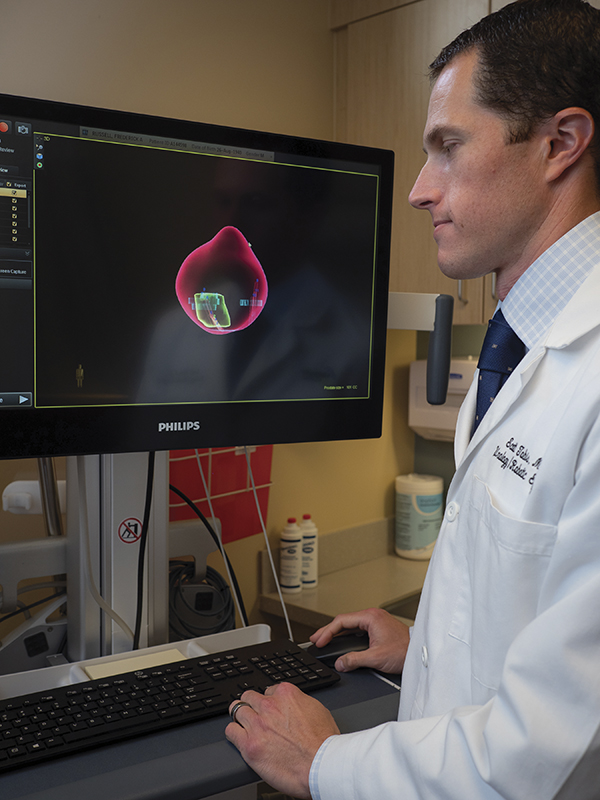
Prostate cancer is one of the most common cancers among men in the U.S. (second after skin cancer) and can often be treated successfully. Advanced imaging technology currently plays a significant role in the identification and diagnosis of prostate cancer.
It is for this reason that the Sansum Clinic Urology Department now offers next-generation prostate imaging using the UroNav Fusion Biopsy System. This sophisticated technology blends pre-biopsy magnetic resonance imaging (MRI) views with ultrasound-guided
biopsy images in real time, producing a detailed, high-quality 3D look at the prostate and any concerning lesions.
In the same way a car’s GPS leads a driver to a destination, the UroNav technology helps the urologist precisely target the area of concern during the procedure. UroNav also provides more complete information that could potentially identify cancer
missed with only a regular biopsy. “UroNav helps to decrease the false negative rate. We don’t want to unnecessarily put patients through more than one biopsy which could possibly delay a diagnosis,” explains Dr. Tobis. “This
allows us to be more precise the first time, meaning better care of the patient by picking up the cancer more quickly and accurately.”
The use of images from Cottage Hospital’s 3 Tesla MRI is an important ingredient to successful use of the UroNav. A 3T MRI has a magnetic field twice as powerful as fields used in conventional MRI scanners. Patients first receive a 3T MRI at the
hospital where radiologists use special software to mark the images and carefully identify any lesions that require targeting. Then, the images are forwarded to the urologist.
The entire process requires a high-level of clear and efficient communication between the two organizations. “I am very proud of the relationships and workflows we have built with our hospital partner, all for the better care of our patients,”
reports Aniko Kim, MPH, Foothill Surgery Center Director of Operations.
Urology Department’s dedicated team member, Nanette Halasz, RN, guides and coordinates this process for patients. She works as a bridge between the doctors and the hospital, and is a comforting presence in the procedure room. “Nanette has
been a champion for this. She has taken on the scheduling, planning, and performance of all of our MRI/US fusion biopsies, along with rapidly learning and implementing all the technical aspects,” notes Dr. Tobis. Nanette reassures those in her
care that the few extra minutes added to the biopsy procedure to use the UroNav is well worth it. “I say, if you are having this done and you have cancer, you want the doctor to find it. This is the whole reason you are here. No one wants to
have cancer, but if you have it, you want it found and treated,” she confirms.
During the in-clinic procedure, the urologist places an ultrasound probe next to the prostate under local anesthesia, similar to a traditional biopsy for prostate cancer. However using UroNav, the physician is better able to locate, flag and biopsy
the kinds of abnormalities that often turn out to be cancer. These abnormalities are sometimes found in a part of the gland that is not usually displayed during a traditional biopsy.
The board-certified UroNav team which includes Dr. Tobis, Dr. Alex Koper, Dr. Daniel Curhan and Dr. Ron Golan, has performed more than 100 of these state-of-the-art biopsies since April of 2020. Procedures have continued during the pandemic with enhanced
safety precautions. “Already we have had patients whose cancers would not have been detected without this technique,” assures Dr. Tobis. “It’s changed the course of treatment for the better for those people.”
The imaging and subsequent biopsies created using UroNav give patients the best possible information to make critical decisions about their care and treatment. Plus, all of the images and medical data are saved in their electronic health record so if
future biopsies are required, there is a point of comparison. Dr. Tobis adds that not all prostate cancer needs to be treated. Some patients can remain on active surveillance. If a patient determines with their urologist to delay intervention, the
UroNav adds an added degree of certainty on the best course of action.
The purchase of this state-of-the-art technology was generously funded through philanthropic support secured by Sansum Clinic and the Cancer Foundation of Santa Barbara. To learn more about UroNav or to determine if you could be a candidate for this procedure, call the Urology Department at (805) 681-7564.